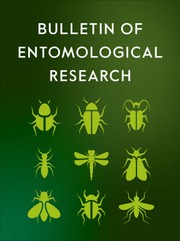Crossref Citations
This article has been cited by the following publications. This list is generated based on data provided by
Crossref.
Challier, A.
1982.
The Ecology of Tsetse (Glossina Spp.) (Diptera, Glossinidae): A Review (1970–1981).
International Journal of Tropical Insect Science,
Vol. 3,
Issue. 2-3,
p.
97.
Dransfield, R. D.
1984.
The Range of Attraction of the Biconical Trap for Glossina pallidipes and Glossina brevipalpis.
International Journal of Tropical Insect Science,
Vol. 5,
Issue. 5,
p.
363.
Jordan, A. M.
and
Green, C. H.
1984.
Visual Responses of Tsetse to Stationary Targets.
International Journal of Tropical Insect Science,
Vol. 5,
Issue. 5,
p.
331.
Owaga, Mary L. A.
1989.
Efficiency of the Biconical Trap and Biases in Catches of Female and Tenerals of Glossina Pallidipes, Austen.
International Journal of Tropical Insect Science,
Vol. 10,
Issue. 5,
p.
651.
Wall, Richard
1989.
Sexual responses of males of Glossina morsitans morsitans Westwood and G. pallidipes Austen (Diptera: Glossinidae) to traps and targets in the field.
Bulletin of Entomological Research,
Vol. 79,
Issue. 2,
p.
335.
WALL, RICHARD
1989.
Ovulation, insemination and mating in the tsetse fly Glossina pallidipes.
Physiological Entomology,
Vol. 14,
Issue. 4,
p.
475.
Kyorku, C.
Brightwell, R.
and
Dransfield, R.D.
1990.
Traps and odour baits for the tsetse fly, Glossina longipennis (Diptera: Glossinidae).
Bulletin of Entomological Research,
Vol. 80,
Issue. 4,
p.
405.
Packer, M.J.
and
Brady, John
1990.
Efficiency of electric nets as sampling devices for tsetse flies (Diptera: Glossinidae).
Bulletin of Entomological Research,
Vol. 80,
Issue. 1,
p.
43.
BURSELL, E.
1990.
The effect of host odour on the landing responses of tsetse flies (Glossina morsitans morsitans) in a wind tunnel with and without visual targets.
Physiological Entomology,
Vol. 15,
Issue. 4,
p.
369.
Hargrove, J.W.
1991.
Ovarian ages of tsetse flies (Diptera: Glossinidae) caught from mobile and stationary baits in the presence and absence of humans.
Bulletin of Entomological Research,
Vol. 81,
Issue. 1,
p.
43.
Randolph, Sarah E.
Rogers, D.J.
Dransfield, R.D.
and
Brightwell, R.
1991.
Trap-catches, nutritional condition and the timing of activity of the tsetse fly Glossina longipennis (Diptera: Glossinidae).
Bulletin of Entomological Research,
Vol. 81,
Issue. 4,
p.
455.
Griffiths, Nigel
and
Brady, John
1994.
Analysis of the components of ‘electric nets’ that affect their sampling efficiency for tsetse flies (Diptera: Glossinidae).
Bulletin of Entomological Research,
Vol. 84,
Issue. 3,
p.
325.
Green, C.H.
1994.
Advances in Parasitology Volume 34.
Vol. 34,
Issue. ,
p.
229.
Hargrove, J.W.
Holloway, M.T.P.
Vale, G.A.
Gough, A.J.E.
and
Hall, D.R.
1995.
Catches of tsetse (Glossina spp.) (Diptera: Glossinidae) from traps and targets baited with large doses of natural and synthetic host odour.
Bulletin of Entomological Research,
Vol. 85,
Issue. 2,
p.
215.
Harris, Marion O.
and
Foster, Stephen P.
1995.
Chemical Ecology of Insects 2.
p.
3.
John, Jeremy Leighton
1997.
The Hamilton-Zuk theory and initial test: An examination of some parasitological criticisms.
International Journal for Parasitology,
Vol. 27,
Issue. 11,
p.
1269.
Ndegwa, P.N.
and
Mihok, S.
1999.
Development of odour-baited traps for Glossina swynnertoni (Diptera: Glossinidae).
Bulletin of Entomological Research,
Vol. 89,
Issue. 3,
p.
255.
Van den Bossche, P.
and
Hargrove, J.W.
1999.
Seasonal variation in nutritional levels of male tsetse flies Glossina morsitans morsitans (Diptera: Glossinidae) caught using fly-rounds and electric screens.
Bulletin of Entomological Research,
Vol. 89,
Issue. 4,
p.
381.
Van den Bossche, P
Shumba, W
and
Makhambera, P
2000.
The distribution and epidemiology of bovine trypanosomosis in Malawi.
Veterinary Parasitology,
Vol. 88,
Issue. 3-4,
p.
163.
Gouteux, Jean-Paul
and
Martin, Louis
2000.
Pièges à Tsé-Tsé en Polyéthylène: Variation Imprévue de L’Attraction pour Glossina fuscipes fuscipes en République Centrafricaine.
International Journal of Tropical Insect Science,
Vol. 20,
Issue. 1,
p.
67.

